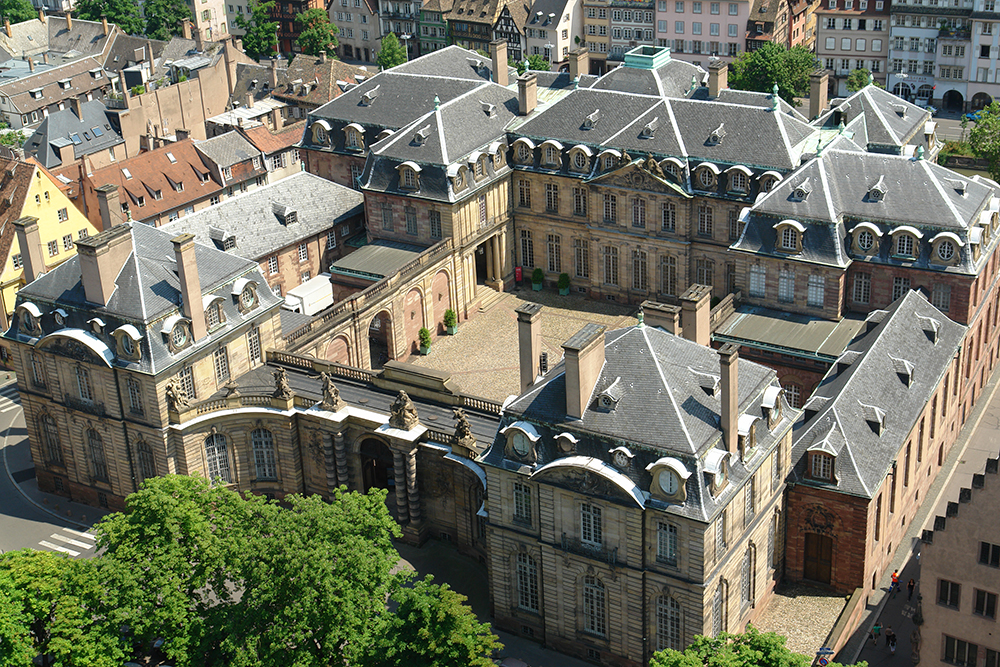Breadcrumb
Détail Entité
The Palais Rohan - the old Episcopal residence
The Palais Rohan: the old residence of the Prince Bishops
The Palais Rohan is a major landmark of 18th-century French architecture. The building was commissioned by Prince Bishop Armand-Gaston de Rohan-Soubise, who wanted to demonstrate the might of the French crown in a city which had just come back under French rule, and also the triumphant return of Catholicism in what was then a bastion of the Protestant Reform.
Since the Reform, French bishops had been residing in Saverne, but the appointment of the powerful Rohan family to the episcopal see of Strasbourg in 1704 provided the opportunity to build a residence in Alsace worthy of the position of the Prince Bishops. The site chosen was the Fronhof, which used to be the bishops’ residence in mediaeval times. The palace was built on the initiative of Armand-Gaston de Rohan-Soubise, Landgrave of Basse-Alsace, Chaplain General of France, the first of the family’s 4 cardinals and possibly even a relative of King Louis XIV himself.
The high opinion Armand-Gaston had of himself was reflected in the splendour of the new building, certainly one of the major architectural achievements of 18th-century France. The architect chosen for this lofty project was Robert de Cotte, who was the king’s architect and then at the height of his powers. Building started in 1732 and was completed 10 years later, under the supervision of Joseph Massol.
A major landmark in French 18th-century architecture, between the river Ill and Notre-Dame Cathedral
The palace was, unusually for the time, built in yellow sandstone and its design was based on the grand Parisian mansions, with the garden replaced by a promenade with a terrace overlooking the river.
The sumptuous main entrance is at the northern part of the building, opposite the Cathedral, through a gateway in the form of a triumphal arch. The many sculptures in the palace were mainly the work of the King’s sculptor, Robert Le Lorrain, exhalting religion, forgiveness, charity and justice. The main part of the building displays a sterner aspect, while the riverside facade features 17 bays around a central avant-corps with 4 columns, crowned with a pediment bearing the coat of arms of the Cardinal.
The inside of the palace is divided into the small appartements on the northern part of the ground floor and the large ceremonial appartements laid out facing the river. The gilded stucco interiors of the King’s bedroom and the Assembly room represent a highpoint of regional rococo art. The king visited the Palace in 1744, and it subsequently became an in an obligatory stop-off for foreign princesses on the eve of their wedding to a French sovereign.
3 museums in the Palais Rohan
In 1790, Louis-René de Rohan-Guéménée, the 4th and last Cardinal, was exiled and this sounded the end of the episcopal residence, which was subsequently converted into a city mansion and then offered, first to Napoleon I and then to Napoleon III. The palace became home to the Musée des Beaux-Arts (Museum of Fine Arts) and the Musée archéologique (Archaeological Museum) in 1889, followed by the Musée des arts décoratifs (Museum of Decorative Arts) in 1918.
- tram A or D - Langstross Grand'Rue
- tram B, C or F - Broglie
- Museum of Fine Arts
- Museum of Decorative Arts
- Archaeological Museum
Address
2 place du Château
67000 Strasbourg
